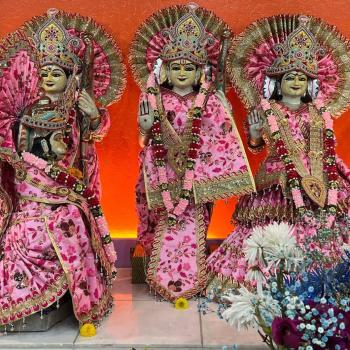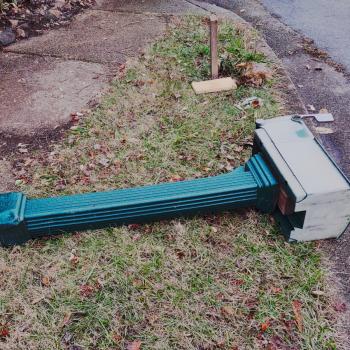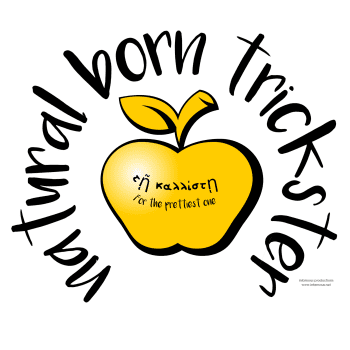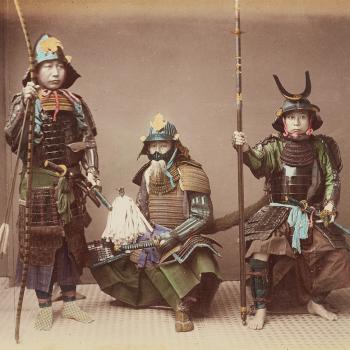Seventy years ago today, my country introduced to the world a new way to sin.
Killing large numbers of innocent people was nothing new, of course. Our ancient histories are full of massacres and ethnic cleansing. Some even think that right at the start of our species or sub-species (depending on how one draws the lines) we slaughtered our Neanderthal cousins to eliminate the competition.
But those past mass slaughters took place over time. Even the firebombing of Hamburg, Dresden, and Tokyo, the most massive incinerations of humans prior to Hiroshima — and acknowledged as war crimes by Curtis LeMay and Robert S. McNamara, men who planned the attacks[McNamara] — took hours to carry out.
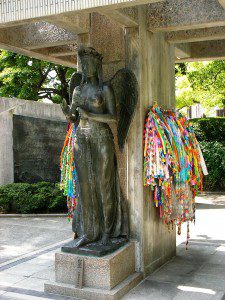
Add the power of the atom, however, and thousands of children (who were working to clear flammable debris in anticipation of an incendiary attack[“Memorial Tower”] could be flash-broiled in an instant.
Of course my government and its apologists continue to say that this massacre was necessary, that it saved lives by ending the war early. It’s nonsense; Japan’s industrial was ruined, its leaders knew the war was over and were trying to negotiate a peace. The only question was the terms of that peace. As the U.S.’s own Strategic Bombing Survey concluded,
Early in May 1945, the Supreme War Direction Council began active discussion of ways and means to end the war, and talks were initiated with Soviet Russia seeking her intercession as mediator.
The talks by the Japanese ambassador in Moscow and with the Soviet ambassador in Tokyo did not make progress. On 20 June the Emperor, on his own initiative, called the six members of the Supreme War Direction Council to a conference and said it was necessary to have a plan to close the war at once, as well as a plan to defend the home islands. The timing of the Potsdam Conference interfered with a plan to send Prince Konoye to Moscow as a special emissary with instructions from the cabinet to negotiate for peace on terms less than unconditional surrender, but with private instructions from the Emperor to secure peace at any price. Although the Supreme War Direction Council, in its deliberations on the Potsdam Declaration, was agreed on the advisability of ending the war, three of its members, the Prime Minister, the Foreign Minister and the Navy Minister, were prepared to accept unconditional surrender, while the other three, the Army Minister, and the Chiefs of Staff of both services, favored continued resistance unless certain mitigating conditions were obtained.
…
Based on a detailed investigation of all the facts, and supported by the testimony of the surviving Japanese leaders involved, it is the Survey’s opinion that certainly prior to 31 December 1945, and in all probability prior to 1 November 1945, Japan would have surrendered even if the atomic bombs had not been dropped, even if Russia had not entered the war and even if no invasion had been planned or contemplated.[U.S. Strategic]
As horrible as the war in the Pacific had been, for all of the perversion of Shintō and Zen into a nationalist cult of war and all the atrocities committed by Japan, the U.S. could have had peace without unleashing nuclear hell if it had been willing to treat Japan as an equal sovereign power and negotiate the sort of treaty between equal more-or-less equal empires that ended the First Sino-Japanese War and the Russo-Japanese War. That’s the sort of war Japan thought it was getting into when it attacked Pearl Harbor — a straight-up fight between expansionist powers over territory and spheres of influence.[Coakley] (Consider just how the U.S. came to have a naval base in the Hawaiian islands in the first place.)
But American pride was too wounded by a sneak attack by an “inferior race”, by a nation that we had forced open to the world less than a century before. Total surrender was a necessity. Plus, we’d spent all that money on the atomic bombs, it would be politically unpalatable for that to be wasted.
And then there were the Russians. The Commies had to be properly cowed, showed in no uncertain terms that the U.S. was going to be in charge of the world when things settled.
All throughout the massacres of the 20th century, but most especially on that day of shame seven decades ago, traditional religions failed. Christianity failed. Buddhism failed. Shintō failed. Every child burned to death in the flash over Hiroshima, every lingering case of radiation poisoning or leukemia, testifies to the fact that the spiritual systems of our past are inadequate to the challenges of a technological species.
We need to do better. It’s a matter of survival of the species.
References:
Coakley, Robert W. “World War II: The War Against Japan”. American Military History, Center for Military History, United States Army. 1989. http://www.history.army.mil/books/AMH/AMH-23.htm
Fallows, James.”But Wait, There’s More: Yasukuni, Arlington, Doolittle, and LeMay”. The Atlantic 30 Dec 2013. http://www.theatlantic.com/international/archive/2013/12/but-wait-theres-more-yasukuni-arlington-doolittle-and-lemay/282723/
“Memorial Tower to the Mobilized Students”. Hiroshima Peace Memorial Museum WebSite. “http://www.pcf.city.hiroshima.jp/virtual/VirtualMuseum_e/tour_e/ireihi/tour_42_e.html
The United States Strategic Bombing Surveys : European war, Pacific war. 30 Sep 1945. Maxwell Air Force Base: Air University Press, 1987.
You can keep up with “The Zen Pagan” by subscribing via RSS or e-mail.
If you do Facebook, you might choose to join a group on “Zen Paganism” I’ve set up there. And don’t forget to “like” Patheos Pagan and/or The Zen Pagan over there, too.






